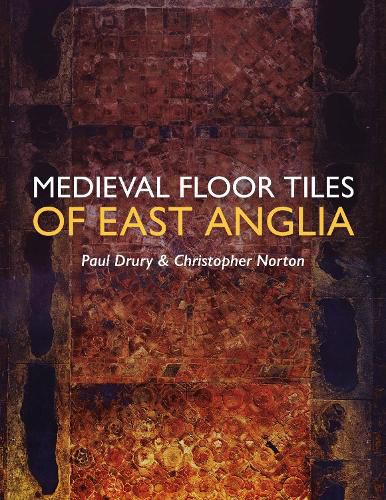Readings Newsletter
Become a Readings Member to make your shopping experience even easier.
Sign in or sign up for free!
You’re not far away from qualifying for FREE standard shipping within Australia
You’ve qualified for FREE standard shipping within Australia
The cart is loading…






The medieval floor tiles of East Anglia span a period of some four centuries and include an unusual variety of decorative techniques and styles. This study traces their manufacture and use in the historic counties of Essex, Suffolk, Norfolk and Cambridgeshire, identifying their distinctive characteristics in comparison with other regions of England, Flanders and northern France. The tiles are also considered in the context of other ceramic building materials in a region that adopted their use early, as well as their relationship to the other decorative arts and crafts that contributed to the appearance of medieval interiors. The sporadic introduction of glazed tiles, some decorated with compass-incised or high relief designs, began around the mid-12th century at high-status royal and monastic sites. The use of decorative tiles accelerated during the mid?late 13th century, with new types appearing, including mosaic, relief and two-color tiles. While London was an important influence and source, production became established elsewhere, seemingly focused on supplying monastic houses. The first half of the 14th century saw settled production at a range of scales, with sub-regional styles emerging, alongside widening patronage including many parish churches. Some production groups have wide distributions, the designs influenced by earlier styles but introducing new elements and new techniques, like line-impressed mosaics and stenciled slip designs. They existed alongside other production centers serving smaller areas with eclectic derivative designs. In the second half of the 14th century, there were fewer centers mostly producing tiles by less labor-intensive means. The import of small plain color tiles (and occasionally decorated ones) from Flanders, laid checker-wise, grew in importance; by the end of the century almost all parish churches and many burgess houses had some glazed tiles. Subsequently large plain tiles, imported and local, became the norm, enlivened by very localized production of decorated large quarries, until the use of glaze on earthenware tiles ceased during the later 16th century. AUTHORS: Paul Drury specialises in an archaeological approach to understanding major buildings, particularly of the 16th and 17th centuries. His interest in floor tiles originated in contextualising the products of a medieval tile factory he excavated in Essex in 1974. He has published widely and served as President of the Society of Antiquaries, 2019?2021. Christopher Norton is Emeritus Professor of Medieval Art and Architecture at the Centre for Medieval Studies and the Department of the History of Art at the University of York. He is the leading authority on medieval floor tiles in France and has published widely on medieval floor tiles on the continent and in Britain. 250 colour and b/w illustrations
$9.00 standard shipping within Australia
FREE standard shipping within Australia for orders over $100.00
Express & International shipping calculated at checkout
The medieval floor tiles of East Anglia span a period of some four centuries and include an unusual variety of decorative techniques and styles. This study traces their manufacture and use in the historic counties of Essex, Suffolk, Norfolk and Cambridgeshire, identifying their distinctive characteristics in comparison with other regions of England, Flanders and northern France. The tiles are also considered in the context of other ceramic building materials in a region that adopted their use early, as well as their relationship to the other decorative arts and crafts that contributed to the appearance of medieval interiors. The sporadic introduction of glazed tiles, some decorated with compass-incised or high relief designs, began around the mid-12th century at high-status royal and monastic sites. The use of decorative tiles accelerated during the mid?late 13th century, with new types appearing, including mosaic, relief and two-color tiles. While London was an important influence and source, production became established elsewhere, seemingly focused on supplying monastic houses. The first half of the 14th century saw settled production at a range of scales, with sub-regional styles emerging, alongside widening patronage including many parish churches. Some production groups have wide distributions, the designs influenced by earlier styles but introducing new elements and new techniques, like line-impressed mosaics and stenciled slip designs. They existed alongside other production centers serving smaller areas with eclectic derivative designs. In the second half of the 14th century, there were fewer centers mostly producing tiles by less labor-intensive means. The import of small plain color tiles (and occasionally decorated ones) from Flanders, laid checker-wise, grew in importance; by the end of the century almost all parish churches and many burgess houses had some glazed tiles. Subsequently large plain tiles, imported and local, became the norm, enlivened by very localized production of decorated large quarries, until the use of glaze on earthenware tiles ceased during the later 16th century. AUTHORS: Paul Drury specialises in an archaeological approach to understanding major buildings, particularly of the 16th and 17th centuries. His interest in floor tiles originated in contextualising the products of a medieval tile factory he excavated in Essex in 1974. He has published widely and served as President of the Society of Antiquaries, 2019?2021. Christopher Norton is Emeritus Professor of Medieval Art and Architecture at the Centre for Medieval Studies and the Department of the History of Art at the University of York. He is the leading authority on medieval floor tiles in France and has published widely on medieval floor tiles on the continent and in Britain. 250 colour and b/w illustrations